The Bridge Between Universal Spirituality and the Physical Constitution of Man
GA 202
I. Soul-and-Spirit in Man's Physical Constitution
17 December 1920, Dornach
Today I want to interpolate a theme which may possibly seem to you somewhat remote, but it will be of importance for the further development of subjects we are studying at the present time. We have been able to gather together many essential details which are essential for a knowledge of man's being. On the one side, we are gradually discovering man's place in the life of the cosmos, and on the other, his place in the social life. But it will be necessary today to consider certain matters which make for a better understanding of man's being and nature.
When man is studied by modern scientific thinking, one part only of the being is taken into consideration. No account whatever is taken of the fact that in addition to his physical body, man also has higher members. But we will leave this aside today and think about something that is more or less recognized in science and has also made its way into the general consciousness.
In studying the human being, only those elements which can be pictured as solid, or solid-fluidic, are regarded as belonging to his organism. It is, of course, acknowledged that the fluid and the aeriform elements pass into and out of the human being, but these are not in themselves considered to be integral members of the human organism. The warmth within man which is greater than that of his environment is regarded as a state or condition of his organism, but not as an actual member of his constitution. We shall presently see what I mean by saying this. I have already drawn attention to the fact that when we study the rising and falling of the cerebral fluid through the spinal canal, we can observe a regular up-and-down oscillatory movement caused by inhalation and exhalation; when we breathe in, the cerebral fluid is driven upwards and strikes, as it were, against the brain-structure; when we breathe out, the fluid sinks again. These processes in the purely liquid components of the human organism are not considered to be part and parcel of the organism itself. The general idea is that man, as a physical structure, consists of the more or less solid, or at most solid-fluid, substances found in him.
Man is pictured as a structure built up from these more or less solid substances (see Diagram I). The other elements, the fluid element, as I have shown by the example of the cerebral fluid, and the aeriform element, are not regarded by anatomy and physiology as belonging to the human organism as such. It is said: Yes, the human being draws in the air which follows certain paths in his body and also has certain definite functions. This air is breathed out again.—Then people speak of the warmth condition of the body, but in reality they regard the solid element as the only organizing factor and do not realize that in addition to this solid structure they should also see the whole man as a column of fluid (Diagram II, blue), as being permeated with air (red) and as a being in whom there is a definite degree of warmth (yellow). More exact study shows that just as the solid or solid-fluid constituents are to be considered as an integral part or member of the organism, so the actual fluidity should not be thought of as so much uniform fluid, but as being differentiated and organized—though the process here is a more fluctuating one—and having its own particular significance.
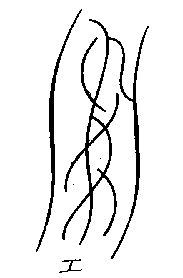
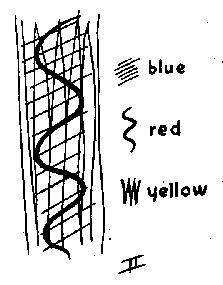
In addition to the solid man, therefore, we must bear in mind the ‘fluid man’ and also the ‘aeriform man.’ For the air that is within us, in regard to its organization and its differentiations, is an organism in the same sense as the solid organism, only it is gaseous, aeriform, and in motion. And finally, the warmth in us is not a uniform warmth extending over the whole human being, but is also delicately organized. As soon, however, as we begin to speak of the fluid organism which fills the same space that is occupied by the solid organism, we realize immediately that we cannot speak of this fluid organism in earthly man without speaking of the etheric body which permeates this fluid organism and fills it with forces. The physical organism exists for itself, as it were; it is the physical body; in so far as we consider it in its entirety, we regard it, to begin with, as a solid organism. This is the physical body.
We then come to consider the fluid organism, which cannot, of course, be investigated in the same way as the solid organism, by dissection, but which must be conceived as an inwardly mobile, fluidic organism. It cannot be studied unless we think of it as permeated by the etheric body.
Thirdly, there is the aeriform organism which again cannot be studied unless we think of it as permeated with forces by the astral body.
Fourthly, there is the warmth-organism with all its inner differentiation. It is permeated by the forces of the Ego.—That is how the human as earthly being today is constituted.
Physical organism: Physical body
Man regarded in a different way:
Solid organism: Physical body
Fluid organism: Etheric body
Aeriform organism: Astral body
Warmth-organism: Ego
Let us think, for example, of the blood. Inasmuch as it is mainly fluid, inasmuch as this blood belongs to the fluid organism, we find in the blood the etheric body which permeates it with its forces. But in the blood there is also present what is generally called the warmth condition. But that ‘organism’ is by no means identical with the organism of the fluid blood as such. If we were to investigate this—and it can also be done with physical methods of investigation—we should find in registering the warmth in the different parts of the human organism that the warmth cannot be identified with the fluid organism or with any other.
Directly we reflect about man in this way we find that it is impossible for our thought to come to a standstill within the limits of the human organism itself. We can remain within these limits only if we are thinking merely of the solid organism which is shut off by the skin from what is outside it. Even this, however, is only apparently so. The solid structure is generally regarded as if it were a firm, self-enclosed block; but it is also inwardly differentiated and is related in manifold ways to the solid earth as a whole. This is obvious from the fact that the different solid substances have, for example, different weights; this alone shows that the solids within the human organism are differentiated, have different specific weights in man. In regard to the physical organism, therefore, the human being is related to the earth as a whole. Nevertheless it is possible, according at least to external evidence, to place spatial limits around the physical organism.
It is different when we come to the second, the fluid organism that is permeated by the etheric body. This fluid organism cannot be strictly demarcated from the environment. Whatever is fluid in any area of space adjoins the fluidic element in the environment. Although the fluid element as such is present in the world outside us in a rarefied state, we cannot make such a definite demarcation between the fluid element within man andr the fluid element outside man, as in the case of the solid organism. The boundary between man's inner fluid organism and the fluid element in the external world must therefore be left indefinite.
This is even more emphatically the case when we come to consider the aeriform organism which is permeated by the forces of the astral body. The air within us at a certain moment was outside us a moment before, and it will soon be outside again. We are drawing in and giving out the aeriform element all the time. We can really think of the air as such which surrounds our earth, and say: it penetrates into our organism and withdraws again; but by penetrating into our organism it becomes an integral part of us. In our aeriform organism we actually have something that constantly builds itself up out of the whole atmosphere and then withdraws again into the atmosphere. Whenever we breathe in, something is built up within us, or, at the very least, each indrawn breath causes a change, a modification, in an upbuilding process within us. Similarly, a destructive, partially destructive, process takes place whenever we breathe out. Our aeriform organism undergoes a certain change with every indrawn breath; it is not exactly newly born, but it undergoes a change, both when we breathe in and when we breathe out. When we breathe out, the aeriform organism does not, of course, die, it merely undergoes a change; but there is constant interaction between the aeriform organism within us and the air outside. The usual trivial conceptions of the human organism can only be due to the failure to realize that there is but a slight degree of difference between the aeriform organism and the solid organism.
And now we come to the warmth-organism. It is of course quite in keeping with materialistic-mechanistic thought to study only the solid organism and to ignore the fluid organism, the aeriform organism, and the warmth-organism. But no real knowledge of man's being can be acquired unless we are willing to acknowledge this membering into a warmth-organism, an aeriform organism, a fluid organism, and an earth organism (solid).
The warmth-organism is paramountly the field of the Ego. The Ego itself is that spirit-organization which imbues with its own forces the warmth that is within us, and governs and gives it configuration, not only externally but also inwardly. We cannot understand the life and activity of the soul unless we remember that the Ego works directly upon the warmth. It is primarily the Ego in man which activates the will, generates impulses of will.—How does the Ego generate impulses of will? From a different point of view we have spoken of how impulses of will are connected with the earthly sphere, in contrast to the impulses of thought and ideation which are connected with forces outside and beyond the earthly sphere. But how does the Ego, which holds together the impulses of will, send these impulses into the organism, into the whole being of man? This is achieved through the fact that the will works primarily in the warmth-organism. An impulse of will proceeding from the Ego works upon the warmth-organism. Under present earthly conditions it is not possible for what I shall now describe to you to be there as a concrete reality. Nevertheless it can be envisaged as something that is essentially present in man. It can be envisaged if we disregard the physical organization within the space bounded by the human skin. We disregard this, also the fluid organism, and the aeriform organism. The space then remains filled with nothing but warmth which is, of course, in communication with the warmth outside. But what is active in this warmth, what sets it in flow, stirs it into movement, makes it into an organism—is the Ego.
The astral body of man contains within it the forces of feeling. The astral body brings these forces of feeling into physical operation in man's aeriform organism.
As an earthly being, man's constitution is such that, by way of the warmth-organism, his Ego gives rise to what comes to expression when he acts in the world as a being of will. The feelings experienced in the astral body and coming to expression in the earthly organization manifest in the aeriform organism. And when we come to the etheric organism, to the etheric body, we find within it the conceptual process, in so far as this has a pictorial character—more strongly pictorial than we are consciously aware of to begin with, for the physical body still intrudes and tones down the pictures into mental concepts. This process works upon the fluid organism.
This shows us that by taking these different organisms in man into account we come nearer to the life of soul. Materialistic observation, which stops short at the solid structure and insists that in the very nature of things water cannot become an organism, is bound to confront the life of soul with complete lack of understanding; for it is precisely in these other organisms that the life of soul comes to immediate expression. The solid organism itself is, in reality, only that which provides support for the other organisms. The solid organism stands there as a supporting structure composed of bones, muscles, and so forth. Into this supporting structure is membered the fluid organism with its own inner differentiation and configuration; in this fluid organism vibrates the etheric body, and within this fluid organism the thoughts are produced. How are the thoughts produced? Through the fact that within the fluid organism something asserts itself in a particular metamorphosis—namely, what we know in the external world as tone.
Tone is, in reality, something that leads the ordinary mode of observation very much astray. As earthly human beings we perceive the tone as being borne to us by the air. But in point of fact the air is only the transmitter of the tone, which actually weaves in the air. And anyone who assumes that the tone in its essence is merely a matter of air-vibrations is like a person who says: Man has only his physical organism, and there is no soul in it. If the air-vibrations are thought to constitute the essence of the tone, whereas they are in truth merely its external expression, this is the same as seeing only the physical organism with no soul in it. The tone which lives in the air is essentially an etheric reality. And the tone we hear by way of the air arises through the fact that the air is permeated by the Tone Ether (see Diagram III) which is the same as the Chemical Ether. In permeating the air, this Chemical Ether imparts what lives within it to the air, and we become aware of what we call the tone.
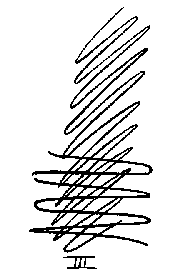
This Tone Ether or Chemical Ether is essentially active in our fluid organism. We can therefore make the following distinction: In our fluid organism lives our own etheric body; but in addition there penetrates into it (the fluid organism) from every direction the Tone Ether which underlies the tone. Please distinguish carefully here. We have within us our etheric body; it works and is active by giving rise to thoughts in our fluid organism. But what may be called the Chemical Ether continually streams in and out of our fluid organism. Thus we have an etheric organism complete in itself, consisting of Chemical Ether, Warmth-Ether, Light-Ether, Life-Ether, and in addition we find in it, in a very special sense, the Chemical Ether which streams in and out by way of the fluid organism.
The astral body which comes to expression in feeling operates through the air organism. But still another kind of Ether by which the air is permeated is connected especially with the air organism. It is the Light-Ether. Earlier conceptions of the world always emphasized this affinity of the outspreading physical air with the Light-Ether which pervades it. This Light-Ether that is borne, as it were, by the air and is related to the air even more intimately than tone, also penetrates into our air organism, and it underlies what there passes into and out of it. Thus we have our astral body which is the bearer of feeling, is especially active in the air organism, and is in constant contact there with the Light-Ether.
And now we come to the Ego. This human Ego, which by way of the will is active in the warmth-organism, is again connected with the outer warmth, with the instreaming and outstreaming Warmth-Ether.
Now consider the following. The etheric body remains in us also during sleep, from the moment of falling asleep to the moment of waking; therefore the interworking of the Chemical Ether and the etheric body continues within our being, via the fluid organism, also while we are asleep. It is different in the case of the astral body and feeling. From the moment of falling asleep to the moment of waking, the astral body is outside the human organism; the astral body and feeling do not then work upon the air organism, but the air organism that is connected with the whole surrounding world—is sustained from outside during sleep. And the human being himself, with his astral body and feeling, goes out of the body and passes into a world with which it is related primarily through the Light-Ether. While he is asleep man lives directly in an element that is transmitted to his astral body by the air organism during waking life. We can speak in a similar way of the Ego and the warmth-organism.
It is obvious from this that an understanding of man's connection with the surrounding universe is possible only as the result of thorough study of these members of being, of which ordinary, mechanistic thinking takes no account at all. But everything in us interpenetrates, and because the Ego is in the warmth-organism it also permeates the air organism, the fluid organism, and the solid organism, it permeates them with the warmth which is all-pervading. Thus the warmth-organism lives within the air organism; the warmth-organism, permeated as it is with the forces of the Ego, also works in the fluid organism.
This indicates how, for example, we should look for the way in which the Ego works in the circulating blood. It works in the circulating blood by way of the warmth-organism—works as the spiritual entity which, as it were, sends down the will out of the warmth, via the air, into the fluid organism. Thus everything in the human organism works upon everything else. But we get nowhere if we have only general, abstract ideas of this interpenetration; we will reach a result only if we can evolve a concrete idea of the constitution of man and of how everything that is around us participates in our make-up.
The condition of sleep, too, can be understood only if we go much more closely into these matters. During sleep it is only the physical body and the etheric body that remain as they are during the waking state; the Ego and the astral body are outside. But in the sleeping human being the forces that are within the physical and etheric bodies can also be active—on the aeriform organism and the warmth-organism as well.
When we turn to consider waking life, from what has been said we shall understand the connection of the Ego with the astral body and with the whole organism. During sleep, when the Ego and the astral body are outside, the four elements are nevertheless within the human organism: the solid supporting structure, the fluid organism, but also the air organism in which the astral body otherwise works, and the warmth-organism in which the Ego otherwise works. These elements are within the human organism and they work in just as regularly organized a way during sleep as during the waking state, when the Ego and the astral body are active within them.
During the sleeping state we have within us, instead of the Ego—which is now outside—the spirit which permeates the cosmos and which in waking life we have driven out through our Ego which is part of that spirit. During sleep our warmth body is pervaded by cosmic spirituality, our air organism by what may be called cosmic astrality (or world-soul), which we also drive out while we are awake.
Waking life and sleeping life may therefore also be studied from this point of view. When we are asleep our warmth-organism is permeated by the cosmic spirituality which on waking we drive out through our Ego, for in waking life it is the Ego that brings about in the warmth-organism what is otherwise brought about by the cosmic spirituality. It is the same with the cosmic astrality; we drive it out when we wake up and readmit it into our organism when we fall asleep. Thus we can say: In that we leave our body during sleep, we allow the cosmic spirit to draw into our warmth-organism, and the world-soul, or the cosmic astrality, into our aeriform organism.
If we study the man without preconceived ideas, we acquire understanding not only of his relation to the surrounding physical world, but also of his relation to the cosmic spirituality and to the cosmic astrality.
This is one aspect of the subject. We can now consider it also from the aspect of knowledge, of cognition, and you will see how the two aspects tally with each other. It is customary to call ‘knowledge’ only what man experiences through perception and the intellectual elaboration of perceptions from the moment of waking to that of falling asleep. But thereby we come to know man's physical environment only. If we adhere to the principles of spiritual-scientific thinking and do not indulge in fantasy, we shall not, of course, regard the pictures of dream-life as immediate realities in themselves, neither shall we seek in dreams for knowledge as we seek it in waking mental activity and perception. Nevertheless at a certain lower level, dreaming is a form of knowledge. It is a particular form of physical self-knowledge. Roughly, it can be obvious that a man has been 'dreaming' inner conditions when, let us say, he wakes up with the dream of having endured the heat of an intensely hot stove and then, on waking, finds that he is feverish or is suffering from some kind of inflammatory condition. In other ways too, dreams assume definite configuration. A man may dream of coiling snakes when something is out of order in the intestines; or he may dream of caves into which he is obliged to creep, and then wakes up with a headache, and so on. Obscurely and dimly, dreams point to our inner organic life, and we can certainly speak of a kind of lower knowledge as being present in dreams. There is merely an enhancement of this when the dreams of particularly sensitive people present very exact reflections of the organism.
It is generally believed that deep, dreamless sleep contributes nothing at all in the way of knowledge, that dreamless sleep is quite worthless as far as knowledge is concerned. But this is not the case. Dreamless sleep has its definite task to perform for knowledge—knowledge that has an individual-personal bearing. If we did not sleep, if our life were not continually interrupted by periods of sleep, we would be incapable of reaching a clear concept of the ‘I,’ the Ego; we could have no clear realization of our identity. We should experience nothing except the world outside and lose ourselves entirely in it. Insufficient attention is paid to this, because people are not in the habit of thinking in a really unprejudiced way about what is experienced in the life of soul and in the bodily life.
We look back over our life, at the series of pictures of our experiences to the point to which memory extends. But this whole stream of remembrances is interrupted every night by sleep. In the backward survey of our life the intervals of sleep are ignored. It does not occur to us that the stream of memories is ever and again interrupted by periods of sleep. The fact that it is so interrupted means that, without being conscious of it, we look into a void, a nothingness, as well as into a sphere that is filled with content. If here (Diagram IV) we have a white sphere with a black area in the middle, we see the white and in the middle the black, which, compared with the white, is a void, a nothingness. (This is not absolutely accurate but we need not think of that at the moment.) We see the black area, we see that in the white sphere something has been left free, but this is equally a positive impression although not identical with the impressions of the white sphere. The black area also gives a positive impression. In the same way the experience is a positive one when we are looking back over our life and nothing flows into this retrospective survey from the periods of sleep. What we slept through is actually included in the retrospective survey, although we are not directly conscious of it because consciousness is focused entirely on the pictures left by waking life. But this consciousness is inwardly strengthened through the fact that in the field of retrospective vision there are also empty places; this constitutes the source of our consciousness in so far as it is inward consciousness. We would lose ourselves entirely in the external world if we were always awake, if this waking state were not continually interrupted by sleep. But whereas dream-filled sleep mirrors back to us in chaotic pictures certain fragments of our inner, organic conditions, dreamless sleep imparts to us the consciousness of our organization as man—again, therefore, knowledge. Through waking consciousness we perceive the external world. Through dreams we perceive—but dimly and without firm definition—single fragments of our inner, organic conditions. Through dreamless sleep we come to know our organization in its totality, although dimly and obscurely. Thus we have already considered three stages of knowledge: dreamless sleep, dream-filled sleep, the waking state.
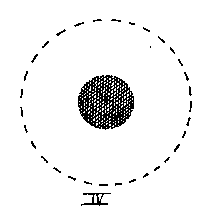
Then we come to the three higher forms of knowledge: Imagination, Inspiration, Intuition. These are the stages which lie above the waking consciousness and as states of consciousness become ever clearer, yielding more and more data of knowledge; whereas below the ordinary consciousness we come to those chaotic fragments of knowledge which are nevertheless necessary for ordinary forms of experience.
This is how we must think of the field of consciousness. We should not speak of having only the ordinary waking consciousness any more than we should speak of having only the familiar solid organism. We must speak to the effect that the solid organism is something that exists within a clearly demarcated space, so that if we think in an entirely materialistic way, we shall take this to be the human organism itself. We must remember that ordinary consciousness is actually present, that its ideas and mental pictures come to us in definite outlines. But we should neither think that we have the solid body only, nor that we have this day-consciousness only. For the solid body is permeated by the fluid body which has an inwardly fluctuating organization, and again the clear day-consciousness is permeated by the dream-consciousness, yielding pictures which have no sharp outlines but fluctuating outlines, for consciousness here itself becomes 'fluid' in a certain sense. And as well as the fluid organism we have the air organism, which during the sleeping state is sustained by something that is not ourselves, and hence is not entirely, but only partially and transiently, connected with our own life of soul—namely in waking life only; nevertheless we have it within us as an actual organism.
We have also a third state of consciousness, the dark consciousness of dreamless sleep, in which ideas and thought-pictures become not only hazy but dulled to the degree of inner darkness; in dreamless sleep we cease altogether to experience consciousness itself, just as under certain circumstances, while we are asleep, we cease to experience the aeriform body. (Diagram V)
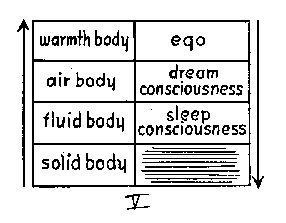
So you see, no matter whether we study the man from the inner or the outer aspect, we reach an ever fuller and wider conception of his being and constitution. Passing from the solid body to the fluid body to the air body to the warmth body, we come to the life of soul. Passing from the clear day-consciousness to the dream-consciousness, we come to the body. And we come to the body in a still deeper sense through the knowledge of being within it through dreamless sleep. When we carry the waking consciousness right down into the consciousness of dreamless sleep and observe the human being in the members of his consciousness, we come to the bodily constitution. When we consider the bodily constitution itself, from its solid state up to its warmth-state, we pass out of the bodily constitution.
This shows you how necessary it is not simply to accept what is presented to biased, external observation. There, on the one side, is the solid body, to which materialistic-mechanistic thought is anchored; and on the other side there is the life of soul which to modern consciousness appears endowed with content only in the form of experiences belonging to the clear day-consciousness. Thought based on external observation alone does not go downwards from this state of consciousness. (See Diagram V: Ego), for if it did it would come to the body. It does not go downwards from the spiritual body (warmth-body), for if it did it would be led to the solid body. This kind of thinking studies the solid body without either the fluid body, the air body or the warmth-body, and the day-consciousness without that which in reality reflects the inner bodily nature—without the dream-consciousness and the consciousness of dreamless sleep.
On the basis of academic psychology, the question is asked: How does the soul-and-spirit live in the physical man?—In reality we have the solid body, the fluid body, the air body and the warmth-body. (Diagram V.) By way of the warmth-body the Ego unfolds the clear day-consciousness. But coming downwards we have the dream-consciousness, and still farther downwards the consciousness of dreamless sleep. Descending even farther (Diagram V, horizontal shading), we come—as you know from the book Occult Science—to still another state of consciousness which we need not consider now. If we ask how what is here on the right (Diagram V) is related to what is on the left, we shall find that they harmonize, for here (arrow at left side), ascending from below upwards, we come to the soul-realm; and here (arrow at right side) we come to the bodily constitution: the right and the left harmonize.
But fundamentally speaking, the externalized thinking of today takes account only of the solid body, and again only of this state of consciousness (Ego). The Ego hovers in the clouds and the solid body stands on the ground—and no relation is found between the two. If you read the literature of modern psychology you will find the most incredible hypotheses of how the soul works upon the body. But this is all due to the fact that only one part of the body is taken into account, and then something that is entirely separated from it—one part of the soul. (Diagram VI, oblique shading.)
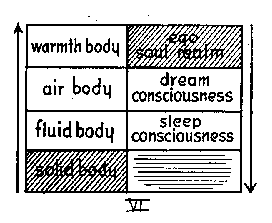
That Spiritual Science aims everywhere for wholeness of view, that it must in very truth build the bridge between the bodily constitution on the one side and the life of soul on the other, that it draws attention to states of being where the soul-element becomes a bodily element, the bodily element a soul-element—all this riles our contemporaries, who insist upon not going beyond what presents itself to external, prejudiced contemplation.

